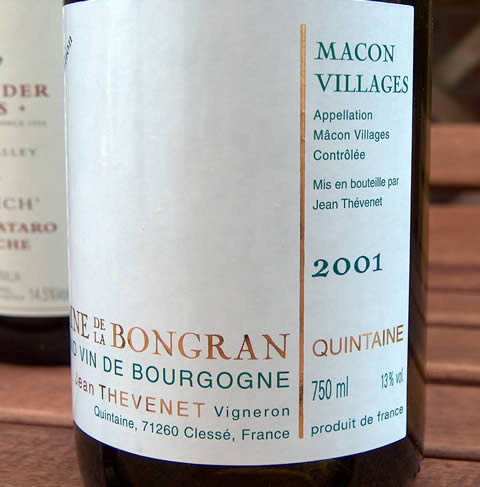|
Extended
tasting note 13
Jean
Thévenet Domaine de la Bongran ‘Tradition’ 2001 Mâcon Villages,
Burgundy, France

It’s
a Sunday night, 8 pm and we’ve just got the kids off to bed after a
very difficult day (they seem to be having lots of these recently; I
don’t remember hating my parents so consistently and forcefully, but
that’s a separate issue). Peace is slowly filtering through into my
inner space—the bird song helps, as I’m sitting outside on a
gorgeous August evening, where the temperature is a comfortable 24
centigrade and everything is still. I’ve put some new potatoes on to
boil, and for tea tonight we’ll be having three trout, which I’ll
grill on the barbie. Time for a glass of wine.
It’s
Mâcon, but not as we know it. Thévenet doesn’t do the usual Mâcon
thing: crisp, bright, fresh and a bit neutral. Instead, he picks very
late, ferments with indigenous yeasts, and comes up with deep coloured,
rich, thick wines, often with a bit of residual sugar and a touch of
botrytis. In fact, he’s been denied the appellation (Mâcon Viré
Clessé) before because his wines aren’t typical. I sympathize, in
as much as I think his wines are great—but, I can also see the other
side. If the appellation is to have meaning, there has to be an agreed
sense of what it means in terms of wine flavours, otherwise it’s no
use as a guide to consumers. Thus while Thevenet’s wines are more
serious than almost all others from the appellation, they taste
different to how a punter would expect a Mâcon Viré Clessé wine to
taste like, and he still gets to call it Mâcon Villages. Besides, it
is hardly going to affect his sales.
The
Cuvée
Tradition is the first in his series of wines, with escalating sugar
levels and ever-later harvests. Yellow–gold, this is Chardonnay in
the mould of late-harvest Loire Chenin, with a nose of minerals, nuts,
honey and herbs.
Time
for an aside: this separation of palate and nose is in reality a false
one. What I mean is that the nose and palate combine to give the taste
(with input from touch and vision, as well). But what we smell stands
on its own, at least initially. So smell can be separated out, but it
itself is a vital part of the palate. Palate includes nose from the
start, and nose initially doesn’t include palate, but no doubt later
does. Does this make sense?
And
then there’s the issue of ‘capturing’ the sensation of a wine.
It’s as if our senses give us snapshots or stills, where what we are
attempting to ‘get’ is more like a movie. Repeated exposure to
tastes and smells results in our perception of them shifting. It’s
all very complicated. Then there’s the difficulty of putting these
snapshot sensations into words. Do we do the wine justice? It’s
worth adding that the idea that we are trying to ‘get’ the wine
suggests that wine tasting is objective: there is something there to
be got.
On
the palate this wine is quite minerally, yet it’s also quite fat,
rich and broad. [Football analogy follows] It’s like a big central
defender doing a step over and then jinking a dainty little pass to
one of his colleagues. There’s complexity here, along with richness
– I guess it’s later summer rather than spring, coming into
autumn. The overall impression is dry, but I reckon there’s a bit of
residual sugar here, along with some apricotty, spicy botrytis notes
in the background. It’s a wine with integrity and soul. And I think
it will go well with the trout I should have been grilling a few
minutes back.
Great
value at £12.74 Andrew Chapman www.surf4wine.co.uk
Website: http://www.bongran.com
Other
ETNs:
Grünhaus;
Roc des Anges; Gaillard;
Veratina; Arturo;
Wynns; Drystone;
Foundry and Columella; Meruge;
Foillard Morgon; Clonakilla;
Latour 1934
tasted
08/06
Back to top
|

